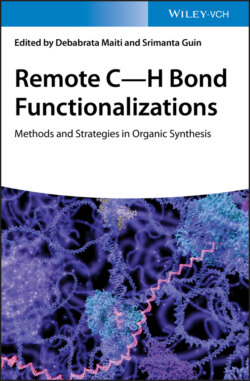Читать книгу Remote C-H Bond Functionalizations - Группа авторов - Страница 21
2.2.5 Phenol Derivatives
ОглавлениеIn 2013, Yu and coworkers achieved an unprecedented meta‐C–H functionalization of electron‐rich phenol derivatives using the 2,2′‐azanediyldibenzonitrile directing template (Scheme 2.46), leading to a synthetically useful method for meta‐functionalizing α‐phenoxycarboxylic acids, the core structure of a fibrate class of drug molecules [43]. Remarkably, the selective C–H functionalization at the meta‐positions of electron‐rich phenol derivatives was especially useful since it is orthogonal to previous electrophilic substitution of phenols in terms of regioselectivity. Notably, meta‐C–H arylation of this class of phenol derivatives was also possible under the same meta‐cross‐coupling conditions of hydrocinnamic acids derivatives with arylboronic esters, although only a limited number of examples were demonstrated.
Scheme 2.46 meta‐C–H olefination of phenol derivatives.
Later in 2017, Zhou, Xu, and coworkers developed a nitrile‐based organosilicon template assisted meta‐C–H olefination of phenol derivatives in good yields with high meta‐selectivities under similar reaction conditions (Scheme 2.47) [44]. Importantly, the organosilicon linkage could be easily cleaved under mild conditions, and the directing template could be recovered under acidic conditions by using p‐toluene sulfonic acid.
Scheme 2.47 Organosilicon template assisted meta‐C–H olefination of phenol derivatives.
Source: Modified from Mi et al. [44].
Subsequently, Sun, Zhou, and coworkers achieved developed an Rh(III)‐catalyzed meta‐selective C–H olefination of phenol derivatives by using the same organosilicon template mentioned earlier (Scheme 2.48) [45]. A range of phenol derivatives and activated alkenes are viable in this reaction to produce meta‐olefinated phenol products in good yields with high meta‐selectivities.
Scheme 2.48 Rh(III)‐catalyzed meta‐C–H olefination of phenol derivatives.
Source: Modified from Mi et al. [45].
Recently, Xu, Jin, Yu, and coworkers developed bifunctional template assisted, palladium‐catalyzed meta‐selective C–H olefination of phenols (Scheme 2.49a), followed by nickel‐catalyzed ipso‐C–O activation and arylation (Scheme 2.49b) [46]. The sequential transformations could be carried out in a one‐pot. Thus, this bifunctional template strategy allowed for the expedited synthesis of multiply substituted arenes. Notably, the novel template could be readily synthesized from inexpensive cyanuric chloride and was easily installed and smoothly removed.
Scheme 2.49 (a) meta‐selective C–H olefination of phenols. (b) Nickel‐catalyzed ipso‐C–O activation and arylation.
Source: (b) Modified from Xu et al. [46].
Finally, Maiti and coworkers also developed a Pd‐catalyzed meta‐C–H olefination of 2‐phenyl phenol derivatives by using the 2‐cyanobenzoyl group as the directing template that was once employed by Li and coworkers for meta‐C–H olefination of phenylethylamines (Scheme 2.50) [47]. Although only a single 2‐phenyl phenol substrate was utilized, the scope of the olefins was broad.
Scheme 2.50 meta‐C–H olefination of 2‐phenyl phenol derivatives.
Source: Modified from Maity et al. [47].
